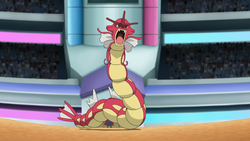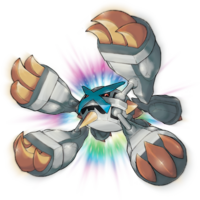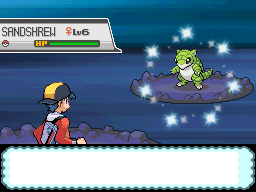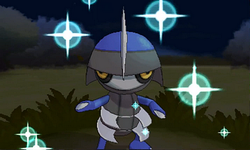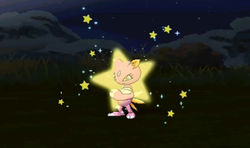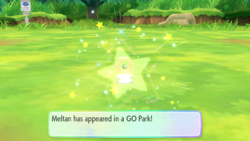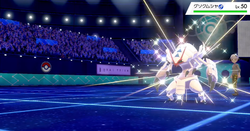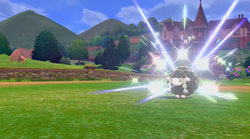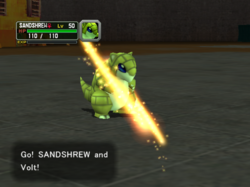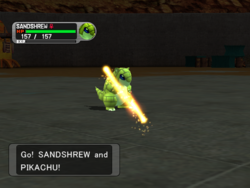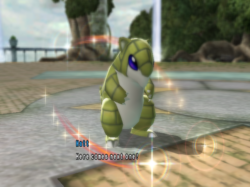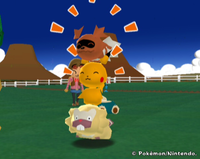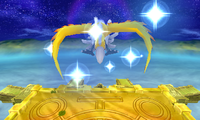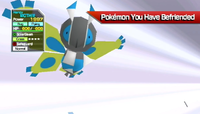Shiny Pokémon: Difference between revisions
m (→In the core series games: Correction) |
|||
| Line 81: | Line 81: | ||
! style="background: #{{gold color}}" | [[#Generation V|Gen. V]] | ! style="background: #{{gold color}}" | [[#Generation V|Gen. V]] | ||
! style="background: #{{gold color}}" | [[#Generation VI|Gen. VI]] | ! style="background: #{{gold color}}" | [[#Generation VI|Gen. VI]] | ||
! style="background: #{{gold color | ! style="background: #{{gold color}}" | [[#Generation VII|Gen. VII]] | ||
! style="background: #{{gold color}}; {{roundytr|5px}}" | [[#Generation | ! style="background: #{{gold color}}; {{roundytr|5px}}" | [[#Generation VIII|Gen. VIII]] | ||
|- style="background: #fff" | |- style="background: #fff" | ||
! class="l" style="background: #{{gold color}}" | [[#Determining Shininess|Base rate]] | ! class="l" style="background: #{{gold color}}" | [[#Determining Shininess|Base rate]] | ||
| colspan="4" | 1/8192 || colspan=" | | colspan="4" | 1/8192 || colspan="3" | 1/4096 | ||
|- style="background: #fff" | |- style="background: #fff" | ||
! class="l" style="background: #{{gold color}}" | [[Pokémon breeding|Breeding]] a Shiny Pokémon<br>if the offspring is the opposite gender | ! class="l" style="background: #{{gold color}}" | [[Pokémon breeding|Breeding]] a Shiny Pokémon<br>if the offspring is the opposite gender | ||
| 1/64 || — || — || — || — || — | | 1/64 || — || — || — || — || — || — | ||
|- style="background: #fff" | |- style="background: #fff" | ||
! class="l" style="background: #{{gold color}}" | [[Masuda method]] | ! class="l" style="background: #{{gold color}}" | [[Masuda method]] | ||
| — || — || 5/8192 || 6/8192 || colspan=" | | — || — || 5/8192 || 6/8192 || colspan="3" | 6/4096 | ||
|- style="background: #fff" | |- style="background: #fff" | ||
! class="l" style="background: #{{gold color}}" | [[Poké Radar]] chaining (single patch): ≥40 | ! class="l" style="background: #{{gold color}}" | [[Poké Radar]] chaining (single patch): ≥40 | ||
| — || — || 41/8192 || — || 1/100<ref>[https://github.com/wwwwwwzx/3DSRNGTool/blob/e6b269611b6ada8ddc169139333b1347d78d4b6a/3DSRNGTool/Gen6/PokeRadar.cs#L52 PokeRadar RNG wwwwwwzx/3DSRNGTool · GitHub]</ref> || — | | — || — || 41/8192 || — || 1/100<ref>[https://github.com/wwwwwwzx/3DSRNGTool/blob/e6b269611b6ada8ddc169139333b1347d78d4b6a/3DSRNGTool/Gen6/PokeRadar.cs#L52 PokeRadar RNG wwwwwwzx/3DSRNGTool · GitHub]</ref> || — || — | ||
|- style="background: #fff" | |- style="background: #fff" | ||
! class="l" style="background: #{{gold color}}" | [[Shiny Charm]] | ! class="l" style="background: #{{gold color}}" | [[Shiny Charm]] | ||
| — || — || — || {{tt|+2/8192|B2 and W2 only}} || colspan=" | | — || — || — || {{tt|+2/8192|B2 and W2 only}} || colspan="3" | +2/4096 | ||
|- style="background: #fff" | |- style="background: #fff" | ||
! class="l" style="background: #{{gold color}}" | [[Friend Safari]] | ! class="l" style="background: #{{gold color}}" | [[Friend Safari]] | ||
| — || — || — || — || 5/4096 || — | | — || — || — || — || 5/4096 || — || — | ||
|- style="background: #fff" | |- style="background: #fff" | ||
! class="l" style="background: #{{gold color}}" | [[Fishing#Generation VI|Consecutive fishing]]: ≥20 | ! class="l" style="background: #{{gold color}}" | [[Fishing#Generation VI|Consecutive fishing]]: ≥20 | ||
| — || — || — || — || 41/4096 || — | | — || — || — || — || 41/4096 || — || — | ||
|- style="background: #fff" | |- style="background: #fff" | ||
! class="l" style="background: #{{gold color}}" | {{DL|DexNav|Hidden Pokémon}}: Search Level 200 + X | ! class="l" style="background: #{{gold color}}" | {{DL|DexNav|Hidden Pokémon}}: Search Level 200 + X | ||
| — || — || — || — || 0.08% + X*0.01% || — | | — || — || — || — || 0.08% + X*0.01% || — || — | ||
|- | |- | ||
! class="l" style="background: #{{gold color}}; {{roundybl|5px}}" | [[SOS Battle]]s: ≥31 | |||
| style="background: #fff" | — | | style="background: #fff" | — | ||
| style="background: #fff" | — | | style="background: #fff" | — | ||
| Line 114: | Line 115: | ||
| style="background: #fff" | — | | style="background: #fff" | — | ||
| style="background: #fff" | — | | style="background: #fff" | — | ||
| style="background: #fff; {{roundybr|5px}}" | | | style="background: #fff" | 13/4096 | ||
| style="background: #fff; {{roundybr|5px}}" | — | |||
|} | |} | ||
{{-}} | {{-}} | ||
Revision as of 01:43, 20 January 2021

A Shiny Pokémon (Japanese: 色違い color variation; 光る shining), previously officially known as alternate coloration or rare coloration, and called Color Pokémon in Pokémon Stadium 2, is a specific Pokémon with different coloration to what is usual for its species. It is one of the many differences that a Pokémon can have within its species.
Form differences, such as that of Shellos and Gastrodon, are not normal/Shiny variations of one another, but the individual forms can be Shiny.
In Pokémon: Let's Go, Pikachu! and Let's Go, Eevee!, a Pokémon's Shininess is visible in the overworld.
Terminology
The term "Shiny Pokémon" was first created by fans to refer to the sparkling sound effect and animation made at the start of an encounter with one in the games. Eventually, this term fell into official usage in Generation IV, used on promotional material promoting Shiny event Pokémon.
The Japanese term "いろちがい" (color variation) is used in several official sources referring to Shiny Pokémon:
- The list of the player's Pokémon from Pokémon Stadium 2.
- Translated in English as "Color Pokémon". Specifically, the player's Pokémon may be listed according to the options "Group Color Pokémon" and "Cancel Color Pokémon".
- The easy chat system from Generation III games.
- Translated in English as "Alt. Color".
- A Wonder Card distributed with a Shiny Milotic in the Japanese version of Pokémon Platinum. Specifically, the 2008 TCG World Championships Milotic, released in 12 October 2008.
- Adapted in English into the "Wow! Shiny Milotic!" Wonder Card, which was received with the US Video Game Championships 2009 Milotic released in 9 May 2009, and then with the UK Video Game Championships 2009 Milotic released in 30 May 2009. These Milotic were also distributed for Pokémon Platinum.
- This is the first use of the word "Shiny" (referring to Shiny Pokémon) in an English game. However, these Wonder Card texts were retrieved with the Milotic distributions, and are not otherwise included in Pokémon Platinum's game data.
- This Japanese word is used in Pokémon Black and White, when a female Ace Trainer mentions Shiny Pokémon, and a male Ace Trainer mentions Shiny Krokorok. They are both located at the same house in Nimbasa City.
- Translated in English with the word "Shiny" in both cases.
- This is the first use of the word "Shiny" (referring to Shiny Pokémon) stored in the data of an English game, instead of received from a Wonder Card.
- In Pokémon Black 2 and White 2, this Japanese word appears in the description of Shiny Charm.
The Japanese word "光る" (shining) is sometimes used in official sources as well.
- The Shining Pokémon from the Trading Card Game use the word "ひかる" in Japanese. For instance, the Shining Gyarados (Japanese: ひかるギャラドス) card.
- A Japanese webpage about Pokémon Stadium 2 on Nintendo.co.jp refers to Shiny Pokémon with the word "光る".[1]
- Ken Sugimori's artwork "Pokémon Gallery: Encounter with Shiny Pokémon" (Japanese: 光るポケモンとの遭遇) uses the word "光る".[2]
- The Shiny Charm (Japanese: ひかるおまもり Shining Charm) uses that word in its Japanese name as well.
- From Pokémon X and Y onwards, the Japanese description of Shiny Charm mentions Shiny Pokémon with the word "ひかる" as well.
Design
Shiny Pokémon can differ in color from their normal counterparts very little or very much. Some Pokémon, such as Glaceon or Pichu, have a Shiny coloration only a few shades darker or lighter in color. Conversely, some Pokémon, such as Caterpie, have dramatic differences in color.
An evolutionary line is not necessarily guaranteed to have similar Shiny colorations even if their standard colorations are the same; both Ponyta and Rapidash have orange flames, but a Shiny Ponyta has blue flames while a Shiny Rapidash has gray flames (this is switched in Generation II). Sometimes, two Pokémon in an evolutionary line with different standard colorations will have the same Shiny coloration, as in the case of Skitty and Delcatty.
Little is known about how Shiny colorations are chosen. While it is often rumored that early Shiny colorations were determined algorithmically, all Pokémon Shiny colorations are individually defined in the game data[3] and Pokémon with similar palettes have distinct Shiny colorations even in Generation II.[4] James Turner, who has worked as a Pokémon designer since Generation V, stated that the first time he selected Shiny colorations was in Generation VII, when he selected the Shiny colorations of Ultra Beasts he designed.[5]
In the core series games
| Gen II | Stadium 2 | FRLG | Gen IV | Gen V | Gen VI | SMUSUM | SMUSUM Pokédex |
PE | Gen VIII | HOME Mobile |
|---|---|---|---|---|---|---|---|---|---|---|
Shiny Pokémon were introduced in the Generation II games. When a Shiny Pokémon appears in the wild or from its Poké Ball, it is surrounded by a flash of stars or light, which is accompanied by a pinging sound effect.
Individual Pokémon cannot change their Shininess. A Shiny Pokémon will always be Shiny, and a regular Pokémon will never become Shiny. Upon evolution, a Pokémon retains its Shiny status; for example, a Shiny Charmander, if leveled up, will eventually become a Shiny Charmeleon and then a Shiny Charizard, while a regular Charmander will become a regular Charmeleon and then a regular Charizard.
An icon (seen in the table above) appears on the status screen of Shiny Pokémon in most games. In Generation II, this icon appears in the top-right corner of the screen, by the gender symbol, while in most other games, it appears in or near one of the corners of the Pokémon's image; however, Pokémon Ruby, Sapphire, and Emerald do not have any icon. In Generation III, the Pokémon's Pokédex number will be colored gold instead of white and the background of the Pokémon's image has a lighter shade; likewise, in Generation IV and V, the color of some elements of the status screen differ for Shiny Pokémon.
The table below summarizes the rates at which Shiny Pokémon can be found by the methods that will be detailed below. The Shiny Charm can directly add to the odds for most methods, with hidden Pokémon being affected uniquely.
| Gen. II | Gen. III | Gen. IV | Gen. V | Gen. VI | Gen. VII | Gen. VIII | |
|---|---|---|---|---|---|---|---|
| Base rate | 1/8192 | 1/4096 | |||||
| Breeding a Shiny Pokémon if the offspring is the opposite gender |
1/64 | — | — | — | — | — | — |
| Masuda method | — | — | 5/8192 | 6/8192 | 6/4096 | ||
| Poké Radar chaining (single patch): ≥40 | — | — | 41/8192 | — | 1/100[6] | — | — |
| Shiny Charm | — | — | — | +2/8192 | +2/4096 | ||
| Friend Safari | — | — | — | — | 5/4096 | — | — |
| Consecutive fishing: ≥20 | — | — | — | — | 41/4096 | — | — |
| Hidden Pokémon: Search Level 200 + X | — | — | — | — | 0.08% + X*0.01% | — | — |
| SOS Battles: ≥31 | — | — | — | — | — | 13/4096 | — |
Determining Shininess
Generation II
In Generation II, being Shiny is determined by a Pokémon's IVs. If a Pokémon's Speed, Defense, and Special IVs are all 10, and its Attack IV is 2, 3, 6, 7, 10, 11, 14 or 15, it will be Shiny. Because of this, a Shiny Pokémon traded to a Generation I game and then traded back to Generation II will retain its Shininess, and a Pokémon obtained in Generation I whose IVs meet the requirements for Shininess will also become Shiny when traded to Generation II.
Since the HP IV is calculated from the other four IVs, a Shiny Pokémon's HP IV will always be either 0 or 8. Shiny Pokémon are generally above average in terms of IVs, but only slightly.
The probability of a Pokémon encountered in the wild or obtained as a gift, in-game trade, or event in Generation II having its IVs line up in the above manner is 1/8192 (assuming every IV combination has the same probability, which is usually the case).
The probability differs for bred Pokémon, as their IVs are partially influenced by their parents. Specifically, a parent passes its Special stat (plus or minus 8) and its Defense stat to its children that are the opposite gender from it. (If Ditto is one of the parents, it is always the one that passes these stats.) This means that if a Shiny parent passes its IVs to a child, the child's inherited Defense IV will always be 10, its inherited Special IV will have a 1/2 chance of being 10, its randomly generated Attack IV will have a 1/2 chance of being an appropriate value, and its randomly generated Speed IV will have 1/16 chance of being 10. This results in a 1/64 chance that such a child will be Shiny. These breeding mechanics also mean that if a child inherits its IVs from a Pokémon that does not have a Defense IV of 10 and a Special IV of 2 or 10, it cannot be Shiny.
Transferring from Generation I Virtual Console games
Pokémon transported to Pokémon Bank from the Virtual Console releases of the Generation I games via Poké Transporter may be Shiny after being transported. Since Version 1.3 of Poké Transporter, this is determined the same way as in the Generation II games. Prior to Version 1.3, the roles of the Attack and Defense IVs were swapped, meaning that the process did not properly correspond to Generation II.
The same quirks that apply to transferring Pokémon from Generation I to Generation II games also apply.
The Mew that were distributed to the Generation I Virtual Console games have IVs of 15 in every stat, meaning they can never be Shiny.
Generation III onward
- Main article: Personality value#Shininess
From Generation III onward, whether a Pokémon is Shiny depends on the Pokémon's Original Trainer's ID number and secret ID number, as well as the Pokémon's personality value. The exact calculation is:
TrainerID xor SecretID xor PersonalityValue31..16 xor PersonalityValue15..0
where the latter two values represent the highest and lowest 16 bits of the 32-bit personality value respectively.
The above formula can result in a number ranging from 0 to 65535. In Generations III to V, if this result is less than 8, then the Pokémon is Shiny; starting in Generation VI, this threshold was increased to 16. For Generations III to V, this gives an overall probability of 8/65536 or 1/8192, exactly the same as in Generation II. For Generations VI and later, the probability is doubled. In Generation VIII, if this result equals 0, then the Pokémon has square Shiny sparkles.
Generation II
In-game Shiny Pokémon
In Generation II, any Pokémon can be Shiny, but the game includes a red Gyarados that the player must encounter at the Lake of Rage during the course of the story. In Pokémon Crystal, the Odd Egg also has a high chance of hatching a Shiny Pokémon: 50% in Japanese games, and 14% in all other languages. [citation needed]
In the Game Boy mode of Pokémon Gold and Silver, the sprites of both regular and Shiny Pokémon use the same shades of gray. A Shiny Pokémon can still be identified by the stars on its status screen or the animation shown when it comes into battle.
Quirks
Pokémon that are transferred from Generation I games may also be Shiny, depending on their IVs. Due to correlations between pseudorandom numbers in the Generation I games, Pokémon encountered in those games in tall grass, on cave tiles, or by Surfing on water cannot have a set of IVs that would allow them to be Shiny in Generation II. Fishing encounters, gift Pokémon (including from Pokémon Stadium), stationary Pokémon (such as Snorlax and Mewtwo), and in-game trades can have any set of IVs, so they always have the same 1/8192 chance of having a Shiny IV combination.[7]
Additionally, in Generation I, if a wild Pokémon transforms again while already transformed, when caught it will be a Ditto with the same DVs as the first Pokémon it transformed into, allowing Ditto's DVs to be manipulated so that it is Shiny in Generation II by having it initially transform into a Pokémon with Shiny DVs.
Generation III
In-game Shiny Pokémon
In Generation III, some Shiny Pokémon appear on NPCs' teams. In Pokémon FireRed and LeafGreen, three Trainers in the Trainer Tower have Shiny Pokémon: the Trainer on the seventh floor in the Single Battle mode has a Shiny Meowth, the pair of Trainers on the first floor in the Double Battle mode have a Shiny Espeon, and the second Trainer on the fourth floor in the Knockout Mode has a Shiny Seaking. Several Pokémon Battle e Trainers also have Pokémon which are preset as Shiny.
Quirks
A bug with the way Shininess is handled for Eggs can cause the Shiny status of a Pokémon hatched from an Egg to differ from the Egg hatching animation. This means that a hatched Pokémon may appear to be Shiny during the hatching animation, but actually not be, and vice versa. This happens because an Egg is initially given the OT, Trainer ID and secret ID of the game in which it is generated, and if it is hatched in a different game, the hatched Pokémon will be given the Trainer details of that game's player; the problem originates in the fact that this update does not occur until after the cutscene of the Egg hatching, so while it may be Shiny for the player who hatched it, it may not be Shiny for the player who obtained the Egg (or vice versa). This also allows Eggs obtained from event distributions (which in Generation III were only distributed in Japan) to hatch a Shiny Pokémon when they would otherwise be non-Shiny Pokémon. This bug was not fixed until Generation VI.
Unown also has an uneven distribution of Shiny probability depending on its form. This is because Unown's form is also determined by its personality value. The exact probability for any given form depends on the player's Trainer ID and Secret ID, but it can have the values 1/5120, 1/6144, 1/9216, 1/10240, or 1/18432.
Generation IV
In-game Shiny Pokémon
In the Generation IV remakes of Generation II's Pokémon Gold and Silver, Pokémon HeartGold and SoulSilver, the player once again must encounter a red Gyarados at the Lake of Rage during the course of the story.
In HeartGold and SoulSilver, a Shiny Pokémon's coloration is reflected in the overworld if it is used as a walking Pokémon.
Methods of increasing Shiny rates
Generation IV introduced the first ways to increase the chances of finding a Shiny Pokémon.
The Masuda method refers to breeding two Pokémon originating from games of different languages to increase the chances of breeding a Shiny Pokémon. Under these circumstances, the game generates up to five total personality values to attempt to find one that will be Shiny. Foreign language Pokémon obtained via in-game trades, such as the Meister's Foppa and Lt. Surge's Volty, still count as being from the same game, so they do not activate the Masuda method unless traded to a different language. This mechanic is retained in all subsequent games.
The Poké Radar slowly improves the odds of finding a Shiny Pokémon as the player builds a chain. The odds can reach a maximum of 41/8192 (approximately 1/200) for a single patch of grass for a chain of length 40 or higher; since up to four patches of grass can shake, the total odds become approximately 1/50. If the Poké Radar forces a Pokémon to be Shiny, it constructs a semi-random personality value that will fulfill the requirement for the Pokémon to be Shiny.
Quirks
Cute Charm can make it possible for players with certain Trainer ID number and Secret ID combinations to manipulate the chance of Pokémon with specific gender ratios being Shiny to be as high as 21.34% (while making the chance lower for all other players and Pokémon with different gender ratios, while using the Ability). This is due to how Cute Charm forces a wild Pokémon to be a specific gender when it activates, which is accomplished by modifying the Pokémon's personality value to be one of an extremely limited set of values.
The bug from Generation III that can cause a Pokémon's Shiny status to differ from the hatching animation persists. This again allows Eggs obtained from event distributions (which in Generation IV were only distributed in Japan) and the Manaphy Egg to be Shiny after hatching.
Generation V
In-game Shiny Pokémon
Generation V introduced a mechanism often referred to as a "Shiny lock", preventing wild Reshiram, Zekrom, and Victini from being Shiny. Any Pokémon obtained in Entree Forest (i.e., from the Pokémon Dream World) are also prevented from being Shiny. Reshiram, Zekrom, and Victini still have Shiny sprites in the games' data.
In Pokémon Black 2 and White 2, the player can obtain three specific Shiny Pokémon (but only two per version). If the player registers every non-event Pokémon in the List of Pokémon by Unova Pokédex number, they can receive a Permit that allows them to travel to the Nature Preserve, where they can encounter a Shiny Haxorus. After defeating Benga in the Black TowerB2 or White TreehollowW2, Benga will give the player a Shiny GibleB2 or Shiny DratiniW2.
Starting in Generation V, Pokémon in the Pokédex will appear Shiny if the first specimen of that Pokémon encountered was Shiny.
Methods of increasing Shiny rates
The Masuda method now generates up to six total personality values instead of five. This remains the case in later games.
Generation V also introduces the Shiny Charm, a Key Item that causes the game to generate up to two extra personality values in an attempt to make a wild or bred Pokémon Shiny. This effect can stack with the Masuda method's effect. This item is also available in all future games.
Quirks
The bug from Generation III that can cause a Pokémon's Shiny status to differ from the hatching animation persists. This again allows Eggs obtained from event distributions to be Shiny after hatching.
Generation VI
In-game Shiny Pokémon
Generation VI slightly changed how Shiny Pokémon are determined to double the default chances that a Pokémon will be Shiny. The basic formula remains the same, but the threshold for a Pokémon to be Shiny is now 16 instead of 8. This results in a base Shiny probability of 16/65536 or 1/4096.
The following Pokémon are prevented from being Shiny when encountered as wild Pokémon in Generation VI games: the Legendary birds, the aura trio, Mewtwo, the weather trio, and Deoxys. The in-game gift Cosplay Pikachu also cannot be Shiny.
Methods of increasing Shiny rates
The Poké Radar returns for Pokémon X and Y. The exact mechanics of the Poké Radar in these games are not confirmed, but the Poké Radar can still force a Pokémon in a shaking patch to be Shiny.
In X and Y, in the Friend Safari, Shiny Pokémon are more common. The game achieves this by generating up to four extra personality values when checking if a Pokémon will be Shiny. This effect can stack with the Shiny Charm's effect.[8]
Consecutive fishing can increase the odds of finding a Shiny Pokémon as the player builds a chain of reeled-in Pokémon by fishing from the same spot. For every Pokémon added to the chain, the game tries two extra personality values to attempt to make the Pokémon Shiny, up to a chain of 20 Pokémon, at which point the chances reach a maximum of 41/4096 or approximately 1%. This effect can stack with the Shiny Charm's effect.[9]
In Pokémon Omega Ruby and Alpha Sapphire, hidden Pokémon have a chance to be forced to be Shiny. Unlike most other methods that increase the odds of finding a Shiny Pokémon, this does not increase the number of personality values that the game tries, but instead executes a custom algorithm to decide whether to force a Shiny personality value. In brief summary, the chances of forcing a Shiny Pokémon grow steadily from 0% at Search Level 0 to 0.06% at Search Level 100 (only surpassing the natural odds of finding a Shiny Pokémon at Search Level 41), then grows steadily to 0.08% at Search Level 200, after which the rate of growth becomes 0.01% for every 100 Search Levels. Certain factors can increase the odds further by performing the check extra times. There is a random 4% chance it will be performed four extra times; if the player has the Shiny Charm it will be performed two extra times; and if the player is encountering the 50th or 100th Pokémon in a chain of hidden Pokémon, it will be performed five or ten extra times respectively. All of these bonuses stack.[10]
Generation VII
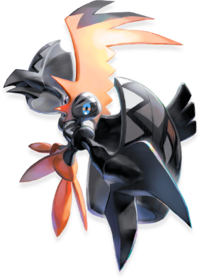
In-game Shiny Pokémon
In Pokémon Sun, Moon, Ultra Sun, and Ultra Moon, after entering the Hall of Fame, Sightseer Marcus appears at the Seafolk Village Pokémon Center, battling the player with a Shiny Exeggcute. This marks the only time a Trainer outside of a battle facility uses a Shiny Pokémon (excluding capture tutorials).
Methods of increasing Shiny rates
Sun and Moon
In the Pokémon Sun and Moon, as well as Ultra Sun and Ultra Moon, as Pokémon in SOS Battles continue calling in allies, the chance that they will be Shiny increases. At chain lengths of 11, 21, and 31, the game will check up to four extra personality values to find a Shiny Pokémon (meaning the maximum number of personality values checked will be 13 for a chain of 31 Pokémon or more). In Pokémon Sun and Moon, the chain length resets to 0 after 255, but in Pokémon Ultra Sun and Ultra Moon, it does not reset. This effect can stack with the Shiny Charm's effect.[11]
Ultra Sun and Ultra Moon
In Pokémon Ultra Sun and Ultra Moon, Pokémon encountered through the Ultra Warp Ride (excluding Legendary Pokémon and Ultra Beasts) have a chance to be forced to be Shiny. The Shininess of these Pokémon is determined when the player arrives at the Ultra Space Wilds. The probability that a Pokémon encountered this way will be Shiny depends on the rarity of the wormhole and the distance traveled.[12]
| Distance (ly) | 0 rings | 1 ring | 2 rings | 3 rings |
|---|---|---|---|---|
| 0–999 | 1% | N/A | N/A | N/A |
| 1000–1499 | 2% | 3% | ||
| 1500–1999 | 3% | 5% | ||
| 2000–2499 | 4% | 7% | ||
| 2500–2999 | 5% | 9% | 16% | |
| 3000–3499 | 6% | 11% | 20% | |
| 3500–3999 | 7% | 13% | 24% | |
| 4000–4499 | 8% | 15% | 28% | |
| 4500–4999 | 9% | 17% | 32% | |
| 5000+ | 10% | 19% | 36% |
Note that 3-ring "blooming" wormholes will always contain Legendary Pokémon (which do not have increased odds of being Shiny), unless all Legendary Pokémon that could be encountered in that particular wormhole have already been caught.
Let's Go, Pikachu! and Let's Go, Eevee!
In Pokémon: Let's Go, Pikachu! and Let's Go, Eevee!, Shiny Pokémon rates can be increased dramatically with catch combos and lures. However, combos past 31 will have no additional effect on shiny chance.
| Catch Combo | Shiny Rate | Lure | Shiny Charm | Lure + Shiny Charm |
|---|---|---|---|---|
| 0–10 | 1 in 4096 | 1 in 2048 | 1 in 1365 | 1 in 1024 |
| 11-20 | 1 in 1024 | 1 in 819 | 1 in 682 | 1 in 585 |
| 21-30 | 1 in 512 | 1 in 455 | 1 in 409 | 1 in 372 |
| 31+ | 1 in 341 | 1 in 315 | 1 in 292 | 1 in 273 |
Catch combos affect all Pokémon, so if the player has a catch combo of 31 Pikachu, all Pokémon have a 1 in 314 chance of being shiny. However, the Pokémon the player has a catch combo for will be more common.
With a catch combo of 31 or higher, a Shiny Charm, and a Lure, the highest chance of 1 in 273 can be reached.
The above three Shiny-increasing methods have no effect on in-game trades or Gift Pokémon.[13]
Generation VIII
Pokémon that appear in the overworld use their standard coloration, regardless of whether they are Shiny or not. They will not be revealed to be Shiny until they are encountered.
Variants
In Pokémon Sword and Shield, there are two different types of Shiny Pokémon, distinguished only by the type of sparkle animation that plays when they enter battle. One type has a star sparkle similar to the Shiny animations in previous generations, and is more commonly found on Pokémon hatched from Eggs, received as gifts, or encountered in Max Raid Battles in Sword and Shield, as well as Pokémon transferred from previous games with Pokémon HOME. All Shiny Pokémon obtained from Dynamax Adventures have star sparkles. The other type has square sparkles, and is more commonly found on wild Pokémon encountered in Sword and Shield.
Like Shininess itself, the type of Shiny sparkle a Pokémon has is determined by its personality value. Ordinarily, there is a 15/16 chance of a Pokémon having a personality value that yields star sparkles, and a 1/16 chance of it having a personality value that yields square sparkles, and indeed this holds true for Pokémon obtained in ways other than wild encounters in Sword and Shield, and for most Pokémon transferred from previous games. However, due to differences in the way the game calculates personality values for different encounter types, these rates are inverted for Pokémon met in wild encounters, having a 15/16 chance of square sparkles and a 1/15 chance of star sparkles.
There are also situations in which a Pokémon is guaranteed to have square sparkles. Pokémon that are forced to be Shiny by the game (which occurs in certain Max Raid Battles during Wild Area News events) will always be assigned a personality value that yields square sparkles. Shiny Pokémon met in a fateful encounter are also guaranteed to have square sparkles (in the case of fateful encounter Pokémon transferred from a previous game that would otherwise have star sparkles, their personality value will be slightly altered to change their sparkle type).
In-game Shiny Pokémon
The following Pokémon are prevented from being Shiny when encountered as wild Pokémon: the Galarian Slowpoke at Wedgehurst Station, Zacian, Zamazenta, and Eternatus. Additionally, the player's starter Pokémon from Leon, the gift Toxel from the Pokémon Nursery, the Type: Null at the Battle Tower, the Kubfu and gift Porygon from the Master Dojo, all of the gift Pokémon from the Diglett Trainer, and in-game gift Gigantamax Factor Pokémon cannot be Shiny.
Pokémon that are too high a level for the player to catch with the current Badges (described as "very strong-looking" in-game) cannot be Shiny, except Pokémon that appear as static encounters.
Max Raid Battles
Whether the Pokémon currently occupying an active Pokémon Den is Shiny or not is determined when the den becomes active, and will not change if the game is reset. For dens activated with a Wishing Piece, the Shiny status of the Pokémon in the den is also predetermined for every subsequent day the den remains active. The chance of encountering a Shiny Pokémon in a Max Raid Battle is not affected by the Shiny Charm.
Although Pokémon encountered in Max Raid Battles can always be caught regardless of how many Badges the player has, a Shiny Pokémon in a den can still be forced to not be Shiny if its level is too high. If a Pokémon currently residing in a den would normally be Shiny but is forced not to be due to its level being too high, and the player then earns enough Badges to catch Pokémon of that level before the Pokémon in question is defeated or caught or the den deactivates, the Pokémon will then become Shiny.
Wild Area News events
Pokémon Sword and Shield has had six Wild Area News events that each focused on a singular Shiny Pokémon. During these events, one of the 5★ Max Raid Battle encounter slots was guaranteed to be a Shiny Pokémon. As mentioned above, these guaranteed Shiny Pokémon will always have square sparkles.
The following is a list of such events in reverse chronological order:
| Start date | End date | Focus Shiny Pokémon | Notes | Source |
|---|---|---|---|---|
| November 20, 2020 | November 22, 2020 | [1] | ||
| October 30, 2020 | November 1, 2020 | Released for Halloween. | [2] | |
| September 18, 2020 | September 20, 2020 | [3] | ||
| August 6, 2020 | August 9, 2020 | [4] | ||
| July 17, 2020 | July 19, 2020 | Released for Marine Day. | [5] | |
| December 31, 2019 | January 3, 2020 | Released for the Japanese New Year. | [6] |
In addition, at the launch of the The Isle of Armor, uncatchable Zeraora appeared in 3★-5★ raids. In 5★ raids, one of the Zeraora encounters was Shiny and more difficult to defeat. Players eventually received that Shiny Zeraora via Pokémon HOME as a reward for collectively defeating over 1 million Zeraora in Max Raid Battles.
Traded Eggs
Unlike in previous generations, where Eggs keep their original personality values when traded and can potentially go from Shiny to non-Shiny or vice-versa if hatched by a player with a different Trainer ID and Secret ID, Eggs traded in Sword and Shield have their personality values altered according to the receiver's TID/SID to ensure they retain their original Shiny status when hatched on a different game.
Methods of increasing Shiny rates
Catching or defeating a given Pokémon a certain number of times slightly increases the chance that any Pokémon of that species that spawns in the wild will be Shiny (Pokémon hatched from Eggs, received as gifts, or encountered in Max Raid Battles are unaffected). This is done by first determining if extra personality values will be generated (which only occurs a small percentage of the time) and if so, generating those extra personality values in an attempt to find one that is Shiny. The number of extra attempts and the chance those extra attempts will occur increases the more of that Pokémon have been caught or defeated, up to a maximum 3% chance of 5 extra attempts. The Pokémon do not have to be caught or defeated consecutively, and can be defeated in either wild battles (including Max Raid Battles) or Trainer battles (excluding Link Battles, the Battle Tower, or Restricted Sparring). The number of each Pokémon caught or defeated is shown in the Pokédex as "Number Battled".
| No. Battled | Extra Attempts | Chance of Boosted Odds | Boosted Odds | Overall Odds | ||
|---|---|---|---|---|---|---|
| No Charm | Shiny Charm | No Charm | Shiny Charm | |||
| 50 | 1 | 1.5% | 1 in 2048 | 1 in 1024 | 1 in 4035 | 1 in 1359 |
| 100 | 2 | 2% | 1 in 1365 | 1 in 819 | 1 in 3977 | 1 in 1348 |
| 200 | 3 | 2.5% | 1 in 1024 | 1 in 683 | 1 in 3810 | 1 in 1332 |
| 300 | 4 | 3% | 1 in 819 | 1 in 585 | 1 in 3657 | 1 in 1313 |
| 500 | 5 | 3% | 1 in 683 | 1 in 512 | 1 in 3562 | 1 in 1301 |
Appearance
Unobtainable Shiny Pokémon
In all generations since Shiny Pokémon debuted, there are a few species that cannot be legitimately obtained Shiny. This can happen if the Pokémon cannot be Shiny in the wild or as an in-game gift (or cannot be obtained this way at all) and has never been distributed as Shiny. However, with the exception of Pikachu in a cap, and Partner Pikachu and Eevee, all of these Pokémon have Shiny variants in their respective games' code.
Shiny Pokémon denoted with a † could not be received in-game, but could be acquired through events or transferring.
Shiny Pokémon denoted with a ✘ could not be obtained by any means in that generation.
| Pokémon | Generation | ||||||||||||
|---|---|---|---|---|---|---|---|---|---|---|---|---|---|
| II | III | IV | V | VI | VII | VIII | |||||||

|
Cosplay Pikachu | ✘ | |||||||||||
| Pikachu in a cap[note 1] | ✘ | ✘ | |||||||||||
| Partner Pikachu | ✘ | ||||||||||||
| Partner Eevee | ✘ | ||||||||||||
| Articuno | † | ||||||||||||
| Galarian Articuno | ✘ | ||||||||||||
| Zapdos | † | ||||||||||||
| Galarian Zapdos | ✘ | ||||||||||||
| Moltres | † | ||||||||||||
| Galarian Moltres | ✘ | ||||||||||||
| Mewtwo | † | ||||||||||||
| Mew[note 2] | SMUSUM only |
||||||||||||

|
Spiky-eared Pichu | ✘ | |||||||||||
| Unown other than I and V |
✘ | ||||||||||||
| Celebi[note 3] | ✘ | ✘ | ✘ | ✘ | |||||||||
| Kyogre | † | ||||||||||||
| Groudon | † | ||||||||||||
| Rayquaza | † | ||||||||||||
| Deoxys | † | ||||||||||||
| Arceus | ✘ | ✘ | |||||||||||
| Victini | ✘ | ✘ | ✘ | ✘ | |||||||||
| Reshiram | ✘ | ||||||||||||
| Zekrom | ✘ | ||||||||||||
| Keldeo | ✘ | ✘ | ✘ | ✘ | |||||||||
| Meloetta | ✘ | ✘ | |||||||||||
| Ash-Greninja | ✘ | ||||||||||||
| Fancy Pattern Vivillon | ✘ | ✘ | |||||||||||
| Poké Ball Pattern Vivillon | ✘ | ✘ | |||||||||||
| Xerneas | † | ||||||||||||
| Yveltal | † | ||||||||||||
| Zygarde | ✘ | † | |||||||||||
| Hoopa | ✘ | ✘ | |||||||||||
| Volcanion | ✘ | ✘ | |||||||||||
| Cosmog | ✘ | ✘ | |||||||||||
| Cosmoem | ✘ | ✘ | |||||||||||
| Solgaleo | † | ||||||||||||
| Lunala | † | ||||||||||||
| Nihilego | USUM only |
||||||||||||
| Buzzwole | USUM only |
||||||||||||
| Pheromosa | USUM only |
||||||||||||
| Xurkitree | USUM only |
||||||||||||
| Celesteela | USUM only |
||||||||||||
| Kartana | USUM only |
||||||||||||
| Guzzlord | USUM only |
||||||||||||
| Necrozma | † | ||||||||||||
| Magearna | ✘ | ✘ | |||||||||||
| Marshadow | ✘ | ✘ | |||||||||||
| Poipole | † | ||||||||||||
| Naganadel | † | ||||||||||||
| Zeraora | ✘ | ||||||||||||
| Gigantamax Melmetal | ✘ | ||||||||||||
| Zacian | ✘ | ||||||||||||
| Zamazenta | ✘ | ||||||||||||
| Eternatus | ✘ | ||||||||||||
| Kubfu | ✘ | ||||||||||||
| Urshifu | ✘ | ||||||||||||
| Zarude | ✘ | ||||||||||||
| Glastrier | ✘ | ||||||||||||
| Spectrier | ✘ | ||||||||||||
| Calyrex | ✘ | ||||||||||||
- ↑ With the exception of Partner Cap Pikachu, which is available in its Shiny form due to the aforementioned programming error. If transferred from Generation VII to Pokémon HOME, it still lacks a Shiny model.
- ↑ Mew in its Shiny form can be obtained legitimately as part of the Gotta catch 'em all! Station or in the Japanese version of Pokémon Emerald. However, it cannot be obtained legitimately in Pokémon: Let's Go, Pikachu! and Let's Go, Eevee!.
- ↑ Celebi in its Shiny form can be obtained legitimately in the original Japanese version of Pokémon Crystal and the Virtual Console releases of Pokémon Crystal.
Non-playable character's Shiny Pokémon
It is possible for all of the following NPC Pokémon to be Shiny:
- The Poochyena/Zigzagoon that attacks Professor Birch in Pokémon Ruby, Sapphire, and Emerald.
- The Zigzagoon that Wally uses in the capture tutorial in Pokémon Ruby, Sapphire, and Emerald.
- The Ralts that Wally catches in Pokémon Ruby, Sapphire, and Emerald (but only when he catches it and not in subsequent battles).
- The Pokémon that the old man encounters in Pokémon FireRed and LeafGreen.
- Rental Pokémon found in the Battle Factory in Pokémon Emerald.
- Wild Pokémon that appear in the Battle Pike and Battle Pyramid in Pokémon Emerald.
- The Starly that attacks the player in Pokémon Diamond and Pearl.
- Battle Frontier Pokémon used by the AI in Pokémon HeartGold, SoulSilver, and Platinum.
- The Minccino that appears in the "world of Pokémon" intro in Pokémon Black and White.
- The Cinccino that appears in the "world of Pokémon" intro in Pokémon Black 2 and White 2
- The Purrloin that Bianca catches in Pokémon Black 2 and White 2.
- The Fletchling that the rival, Calem or Serena, uses in the capture tutorial in Pokémon X and Y.
- The Bunnelby that the rival, Calem or Serena, captures in the tutorial in Pokémon X and Y.
In the side series games
Pokémon Stadium
In Pokémon Stadium and Pokémon Stadium 2, Pokémon with a nickname can be colored slightly differently, whether or not they are actually Shiny. The colors a nicknamed Pokémon has are determined by the Pokémon's nickname and the Original Trainer's Trainer ID number and name.
In the Ekans Hoop Hurl game in the Kids' Club, there are golden Diglett that are worth extra points.
In Stadium 2, there is an option while viewing the list to exclude any non-Shiny Pokémon from the listing (i.e. Group Color Pokémon/Cancel Color Pokémon). This will show Shininess, even if the player is currently viewing a Generation I cartridge in the Lab.
It is possible for Challenge Cup Pokémon to be Shiny.
Pokémon Colosseum

In Pokémon Colosseum, non-Shadow Pokémon obtained in the game (such as the player's starter Espeon or Umbreon and Duking's Plusle) are prevented from being Shiny.
There is roughly a 1/8192 chance of a Shadow Pokémon being Shiny. When a Shadow Pokémon is first encountered, it is assigned a random personality value, but the game ensures that the personality value does not cause it to be Shiny for its NPC Trainer (using that Trainer's Trainer ID and Secret ID). When the player catches the Shadow Pokémon, because it retains that same personality value but now has a different Trainer ID and Secret ID, it is possible for the Shadow Pokémon to be Shiny for the player. In subsequent encounters, the Shadow Pokémon retains the same personality value it had in the first encounter (meaning that whether it is Shiny for the player or not cannot change); however, because its NPC Trainer's Trainer ID and Secret ID can differ, it can be Shiny for its NPC Trainer in these subsequent encounters.
Purification has not effect on the Shiny status of a Pokémon: Shiny Pokémon remain Shiny, and non-Shiny Pokémon cannot become Shiny.
In Pokémon Colosseum, the color of a Shiny Pokémon can differ drastically from the handheld games.
Pokémon XD
In Pokémon XD, the game ensures that all Shadow Pokémon are not Shiny by recalculating the Pokémon personality value if it would result in a Shiny Pokémon. However, non-Shadow Pokémon (such as the starter Eevee, in-game trades, Mt. Battle Johto starter Pokémon, and Poké Spot Pokémon) can be Shiny.
Like in Pokémon Colosseum, the color of a Shiny Pokémon can differ drastically from the handheld games. Shiny Pokémon have a different profile icon next to their health bar than their normally-colored counterparts.
My Pokémon Ranch
In My Pokémon Ranch, Pokémon's Shininess is visible. Pokémon traded by Hayley—except possibly Phione and Mew[citation needed]—cannot be Shiny.
Pokémon Battle Revolution
In Pokémon Battle Revolution, Shiny Pokémon have face-sprites which show their Shininess. Random Pokémon in Colosseums can be Shiny, but have the same chance of being Shiny as wild Pokémon. This is due to the RNG, which generates a random PID.
In the spin-off games
Pokémon Mystery Dungeon series
Pokémon Mystery Dungeon: Explorers of Time, Darkness and Sky
In Pokémon Mystery Dungeon: Explorers of Time and Explorers of Darkness and Explorers of Sky, a Shiny Celebi is part of the story, although Shiny Pokémon are not obtainable normally in the game.
An aternately colored Kecleon is one of the two brothers who run the main shop in the game. He has a different coloration from both a regular and a shiny Kecleon, being purple instead of green.
Pokémon Mystery Dungeon WiiWare
In the Pokémon Mystery Dungeon games for WiiWare, Shiny Pokémon can be found in dungeons. Unlike the core series, only 36 different species of Shiny Pokémon are obtainable. The chances of finding one in a dungeon is the same as finding one in the wild in the core series. Unlike Shiny Pokémon in the past however, the Shiny Pokémon found in these games have an added bonus: their Belly stat is 200 as opposed to the 100 of normal Pokémon. A Red Gyarados can also be obtained at Level 30 via Wonder Mail password, as a reference to the one found in the Johto-based games.
Pokémon Mystery Dungeon: Gates to Infinity
In Pokémon Mystery Dungeon: Gates to Infinity, Ho-Oh can be uniquely encountered as a Shiny Pokémon at Eternal Ruins through a Legend of the Mysterious Ruins job request. This Shiny Ho-Oh has a slightly different moveset to the regular Ho-Oh that can be met. It also has a unique animation that plays before the battle begins.
Pokémon Super Mystery Dungeon
The Shiny Celebi from Pokémon Mystery Dungeon: Explorers of Time, Darkness, and Sky makes an appearance. She is rescued as part of an expedition and subsequently connects with the player. She has a unique animation that plays when entering a dungeon.
Pokémon Mystery Dungeon: Rescue Team DX
27 Mystery Dungeons, once completed for the first time, will have "Strong Foe" Pokémon that spawn. These Pokémon have a higher than normal chance of being Shiny compared to the main series. Shiny Pokémon cannot be recruited unless the Player has the Friend Bow equipped and the Shiny Pokémon's respective Camp purchased. Recruitment is still not guaranteed if these criteria are met.
Additionally, the Shiny Celebi from past Pokémon Mystery Dungeon games also makes a cameo appearance, and can be recruited after clearing Purity Forest and visiting Mystery Houses—rare rooms that spawn in post-game dungeons—with an invitation.
Super Smash Bros. series
In the Super Smash Bros. series, Pikachu, Jigglypuff, Mewtwo, Squirtle, Ivysaur, Charizard, Lucario, Greninja, and Incineroar each have several different colorations exclusive to the series. One of Pikachu's alternate colorations is its Shiny coloration wearing Red's hat, one of Jigglypuff's in Super Smash Bros. Brawl is its Shiny coloration wearing a straw hat, and one of Incineroar's alternate colorations greatly resembles its Shiny coloration; Mewtwo also has its Shiny coloration in Super Smash Bros. Melee. Squirtle and Ivysaur both have their current Shiny colorations, but Charizard has its original Shiny coloration from Pokémon Gold/Silver/Crystal. All other playable Pokémon in the series do not have their actual Shiny coloration as an alternate coloration.
Pokémon Rumble series
Pokémon Rumble
In Pokémon Rumble, Shiny Pokémon may rarely appear. They will always tip over when defeated. The chances of their appearance are unconfirmed, although they appear to occur more often than in the core series. Shiny Pokémon are always given a special trait, a blue name in menus, and a star below their picture on the Collection screen. Some Shiny Pokémon can be obtained by the use of passwords.
Pokémon Rumble U
Shiny Pokémon return to the Pokémon Rumble series in Pokémon Rumble U though are only obtainable through the use of passwords or the NFC Rumble U Figures.
Pokémon Conquest
A Shiny Rayquaza is featured in Pokémon Conquest, sharing a Perfect Link with Nobunaga, and is his Pokémon of choice during the final battle of the main scenario. Nobunaga's Black Rayquaza was distributed over Wi-Fi for Japanese Black and White players to commemorate the release of the game.
Pokémon Shuffle
There are 15 Shiny Pokémon, including Mega Evolved Pokémon, in Pokémon Shuffle: Charizard, Gengar, Magikarp, Gyarados, Mewtwo, Tyranitar, Ho-Oh, Gardevoir, Metagross, Rayquaza, Genesect, Hawlucha, Xerneas, Yveltal, and Diancie. Shiny Pokémon are treated as alternate forms of the standard Pokémon, sharing its Pokémon list number but not its Skill, experience, level, Mega Effect (where applicable), and sometimes type.
Pokémon GO
- Main article: Shiny Pokémon (GO)
In Pokémon GO, certain Pokémon species have a chance of being Shiny, with each species having its own Shiny rate. For most Pokémon, the Shiny rate is approximately 1 in 450. However, in certain in-game events, the Shiny chance may be increased for certain Pokémon. For example, on Community Days, the featured Pokemon will always have increased Shiny odds. Shiny Pokémon may be encountered through any method: randomly in the wild, from hatching Eggs, by completing Field Research tasks, by winning Raid Battles, or as GO Battle League rewards. All Pokémon seen in the overworld appear non-Shiny, but when a player attempts to capture a Pokémon, it may appear as a Shiny Pokémon. Likewise, during a Raid Battle, the Raid Boss always appears non-Shiny during battle, but it may become Shiny during the bonus challenge. Shiny encounters are random for each player, meaning that if two players attempt to catch the same Pokémon, one player may encounter a Shiny Pokémon and the other may not.
Pokémon Duel
There are several figures that are Shiny Pokémon in Pokémon Duel. These figures are usually posed identically or near-identically to their regular Pokémon counterparts. A Shiny figure's Data Disk is always identical to the regular version's but a few have different Abilities. A Shiny figure cannot evolve or change form into a non-Shiny figure nor vice-versa. Additionally, a Shiny figure cannot be selected to be made into a Golden or Silver Figure. The following is a list of Shiny figures.
Pokémon: Magikarp Jump
A Shiny Magikarp, referred to as a Gold Magikarp, is one of the possible Magikarp to fish in Pokémon: Magikarp Jump. Shiny Feebas, Luvdisc and Corsola may also appear in random encounter events during feeding. If the player breaks the Everstone that the Shiny Magikarp is holding and evolves it into a Gyarados, the Gyarados will also be Shiny.
Pokémon Quest
Pokémon can appear Shiny in Pokémon Quest. When viewing the Pokémon's details, the Pokémon's picture will appear in its shiny coloration. The only benefit to having a Shiny Pokémon in Pokémon Quest is to gain 20 PM Tickets. Otherwise, it is just an aesthetic feature. It is considered that there is a 1/75 to a 1/100 chance of attracting one. In other Pokémon generations and games, stars and swirls would appear if you found a Shiny Pokémon. Pokémon Quest has no indication on whether you attracted a Shiny Pokémon or not.
In the TCG
Shiny Pokémon have appeared in the TCG as well, first as Shining Pokémon in Neo Revelation and Neo Destiny, and later as Pokémon ![]() in EX Team Rocket Returns - EX Power Keepers. The Stormfront, Platinum, Supreme Victors and Arceus sets include three cards each with alternate coloration artwork and a reverse holo effect, but are not classified as an entirely separate rarity. Unlike Shining Pokémon and Pokémon
in EX Team Rocket Returns - EX Power Keepers. The Stormfront, Platinum, Supreme Victors and Arceus sets include three cards each with alternate coloration artwork and a reverse holo effect, but are not classified as an entirely separate rarity. Unlike Shining Pokémon and Pokémon ![]() , these newest alternate coloration cards are not limited by special gameplay and deckbuilding rules, and since the names of the cards are not changed to indicate the alternate coloration, they can be evolved into non-Shiny Pokémon.
, these newest alternate coloration cards are not limited by special gameplay and deckbuilding rules, and since the names of the cards are not changed to indicate the alternate coloration, they can be evolved into non-Shiny Pokémon.
Shiny versions of several Pokémon were also featured as secret rares in the Call of Legends expansion, as well from Next Destinies until Plasma Blast, and in VMAX Rising ownards. Special sets such as Shining Legends and Shiny Vault are also focused on Shiny Pokémon
Sometimes, cards with Shiny Pokémon are tied to ongoing events in the games or anime, such as the Shiny Gengar distributed in October 2014, or the appearance of the Red Genesect in Genesect and the Legend Awakened.
List of cards featuring Shiny Pokémon
In the anime


- Main article: List of alternately colored Pokémon in the anime
Although the games had not premiered alternate colored Pokémon until Generation II, several Pokémon seen beforehand were colored differently. One such example is the pink Butterfree, the mate of Ash's Butterfree, which appeared as early as the twenty-first episode. This is, however, not the standard alternate coloration for a Butterfree, and therefore may not be counted as a Shiny Pokémon. Likewise, the first appearance of a Generation III Pokémon in The Kecleon Caper featured a non-standard alternately colored Pokémon, this time a purple Kecleon. Another example would be in Fighting Back the Tears!, where a non-standard alternately colored Mareanie (who happens to be James's Mareanie's first love) appears, and later evolves into a Toxapex.
In the Orange Archipelago, certain Pokémon have a different coloration because the climate is different than that of the mainland. For example, a Butterfree, instead of the normal white with black markings, would have gold wings with red spots on them. On Pinkan Island of the Orange Archipelago, all of the Pokémon are colored pink because the Pinkan Berries they eat make them that way.
The first true Shiny Pokémon that appeared was a Noctowl in Fowl Play!. Ash eventually caught it, and, as in the games, sparkles surround it as it comes from its Poké Ball. Several other Shiny Pokémon have appeared later as well, often used to make them stand out more, or be the focus of an episode. The term "Shiny" was first used in Working on a Right Move!.
In the manga
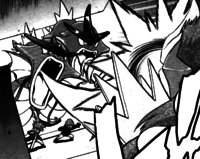
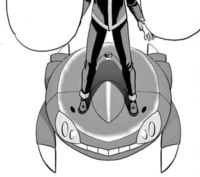
Because most manga series are published in black-and-white, Shiny Pokémon are few and far between. One major exception, because of its importance to the plot of Gold, Silver, Crystal, HeartGold, and SoulSilver, is the red Gyarados.
In the movie adaptations
A Red Genesect appeared in Genesect and the Legend Awakened.
A Shiny Rayquaza appeared in Hoopa and the Clash of Ages. It had the ability to Mega Evolve into a Mega Rayquaza.
In the Pokémon Adventures manga
In the Gold, Silver & Crystal arc, Silver captured the raging leader of a group of Gyarados, who had been on a rampage since Team Rocket took control of the Goldenrod Radio Tower and sent out their evolution-inducing radio waves.
Crystal mentions that she caught a different colored Pineco as part of the Pokémon sent to Professor Oak in Off Course with Corsola.
In the Black & White arc, a Shiny Genesect appears in The Shadow Triad. In the Black 2 & White 2 arc, it was revealed to be owned by Colress.
In the Pocket Monsters HGSS Jō's Big Adventure manga
In Pocket Monsters HGSS Jō's Big Adventure, Jō and his Totodile befriend the red Gyarados by calming its rampage and feeding it Berries. It later appears to help Jō and Lance battle Ariana and Petrel.
In the Pokémon Pocket Monsters manga
The Red Gyarados makes an appearance in Stop That Strange Sonic Sound!! where Team Rocket plots on catching it by luring it out of hiding using sonic waves while at the same time, Clefairy went fishing for it. The Red Gyarados is darker than any normal-colored Gyarados in this media.
Trivia

- In Generation III onwards, it is possible for an Egg to hatch Shiny on one game but not another. This is because Shininess is partially determined by the Original Trainer ID and Secret ID number. Eggs have the ID and SID of the game they were originally bred on, but change to the ID and SID of the hatcher immediately after hatching. It is this change that affects Shininess.
- Confusingly, this means that if a player hatches a traded Egg that would have been Shiny on the game it was originally bred on, it will appear Shiny on the hatching screen (since it still has the ID and SID of the original game), and then suddenly no longer be Shiny afterward (once it has obtained the ID and SID of the hatcher's game). Conversely, it is also possible for a newly hatched Egg to not appear Shiny on the hatching screen and then suddenly become Shiny afterward, if the Egg has been traded.
- While all (Generation III onward) event Eggs are set to prevent or force Shininess, if a player other than the one who obtained it from the event hatches the Egg, this prevention is bypassed, allowing an event Egg to hatch Shiny. This is the only way to obtain a Shiny Manaphy.
- Due to Shininess being determined by IVs in Generation II, several odd quirks arise:
- Since gender is also determined by IVs in Generation II, it is impossible to have a Shiny Pokémon with a gender ratio of seven males to one female that is female in those games, as the highest Attack IV a female Pokémon with a gender ratio of seven males to one female can have is 1, while the lowest Attack IV a Shiny Pokémon can have is 2.
- Since Unown's letter is also determined by IVs in Generation II, only Unown I and V can be Shiny.
- Since Hidden Power is determined by IVs, a Shiny Pokémon's Hidden Power type in Generation II can only be either Grass or Dragon, with a power of either 49 or 69.
- As Generation II does not allow two Pokémon to breed if they have the same Defense IVs, two Shiny Pokémon can never breed in Generation II.
- Pokémon Black 2 and White 2 have the most in-game event Shiny Pokémon available (excluding Wild Area News), with two.
- Before Generation VIII, Castform's weather forms and Magearna's default form had the same colors regardless whether they were Shiny or not (although the latter is not legitimately available in its Shiny coloration).
In other languages
|
Shiny Pokémon
|
Different-colored Pokémon
| ||||||||||||||||||||||||||||||||||||||||||||||||||||||||||||||||||||||||||||||||||||||||||||
See also
References
- ↑ ポケモンスタジアム 金銀 - Nintendo.co.jp
- ↑ https://www.nintendo.co.jp/nom/0205/03/02/index.html 3-2.この春登場、強力・注目 商品ラインナップ - Nintendo.co.jp]
- ↑ Pokémon Gold Disassembly
- ↑ @DrLavaYT on Twitter
- ↑ @JamesTurner_42 on Twitter
- ↑ PokeRadar RNG wwwwwwzx/3DSRNGTool · GitHub
- ↑ Pokémon Red/Blue Wild DVs
- ↑ Friend Safari RNG · wwwwwwzx/3DSRNGTool Wiki · GitHub
- ↑ Pokemon 6G Chain Fishing Probability Analysis
- ↑ Pokemon ORAS DexNav Shiny Encounter Probability Analysis
- ↑ wwwwwwzx on Twitter
- ↑ wwwwwwzx on Twitter
- ↑ https://www.reddit.com/r/PokemonLetsGo/comments/a48ruf/shiny_chances_an_update/

|
This game mechanic article is part of Project Games, a Bulbapedia project that aims to write comprehensive articles on the Pokémon games. |
